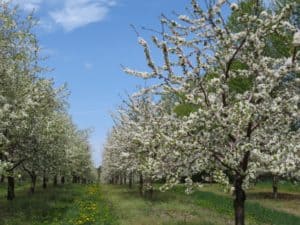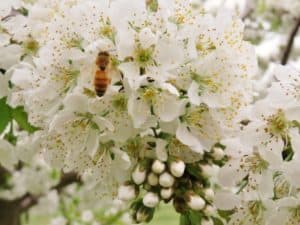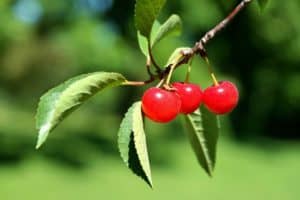The summer of 2017 is an exciting time for the Bee Informed Partnership as industry support and beekeeper interest has facilitated the expansion of a new BIP Tech Transfer Team based in Michigan. This expansion into a new territory means learning about the specifics of the local landscape, agricultural systems and beekeeping calendar in order to better serve the local beekeeping operations. Most Michigan-based beekeeping operations spend the winter in Florida or other warmer states and return to Michigan in the spring for fruit pollination and honey production through the summer and autumn.

Tart cherries are one of the most prevalent pollination crops in Michigan and many beekeepers rent their colonies to orchardists during the spring prior to moving them into summer honey production yards. The Montmorency cultivar makes up nearly all of the commercially produced tart cherry crop nationwide with Michigan accounting for approximately 75% of the tart cherries produced nationally. The industry is centered around the Traverse City area, which is known as the “Cherry Capital of the World” and hosts the National Cherry Festival annually around the 4th of July.
There are 32,000 acres (NASS, 2011) of tart cherry plantings in the state, with the industry concentrated in the “fruit belt” on the western side of the state bordering Lake Michigan. This fruit belt is characterized by sandy loam soils and benefits from the climactic effects of proximity to the big lake with tart cherries generally being hardy in climate zones 4-7. The moderating impact of the lake somewhat delays the bloom timing, therefore lowering the chance of a damaging frost post fruit set. This region of the state also has large acreages of other specialty crops including sweet cherries, apples, peaches, pears, grapes, hops, and a variety of berry crops.

Unlike many varieties of sweet cherries (Prunus avium), tart cherries (Prunus cerasus) are self-fertile, meaning pollen transfer is only required within individual flowers on the same tree and orchard plantings do not need to include pollinizing varieties. Tart cherries bloom in the May when weather in the region can be cool, wet, and windy often hampering pollination efforts. Despite their self-fertile capabilities tart cherries do benefit from honey bee pollination with reports indicating that yields are substantially increased by the presence of honey bee colonies during bloom. Cherry blossoms provide both pollen and nectar to foraging bees. Cherries are a relatively good source of spring pollen which is dark yellow in color but nectar is generally not gathered in quantities large enough to produce substantial yields of surplus.
To maximize pollination in what can be brief windows of suitable conditions growers are recommended to stock honey bee colonies in the orchard at a coverage of 1-1.5 per acre The bloom period for cherries where they are receptive to pollination is generally 7-8 days although this can be accelerated or slowed by hot or cold weather patterns. Bees are typically in for two weeks or less and the rental fees are in the range of $50-55 per colony. Honey bees typically visit cherry blossoms in the morning so it is recommended that growers avoid activities that may disrupt bee activity (such as mowing and spraying) during this time.

In addition to honey bees some growers have begun supplementing hired honey bee colonies with mason bees (Osmia spp). Honey bees do not typically forage at temperatures below 55F so creating suitable habitat for other pollinators that are capable of foraging at lower temperatures can help achieve fruit set during periods of marginal weather. “Over pollination” leading to a need for extensive thinning of fruit is rarely a problem with cherries as it can be in other crops. The crop typically matures 2-3 months after pollination with harvest occurring in mid-July. Harvest is done mechanically by shaking the trunk and collecting the fruit in tarps where it is then immediately submerging it in cold water to preserve freshness limit bruising and separate debris. The vast majority of the crop is processed by freezing, drying, canning, or juicing.

